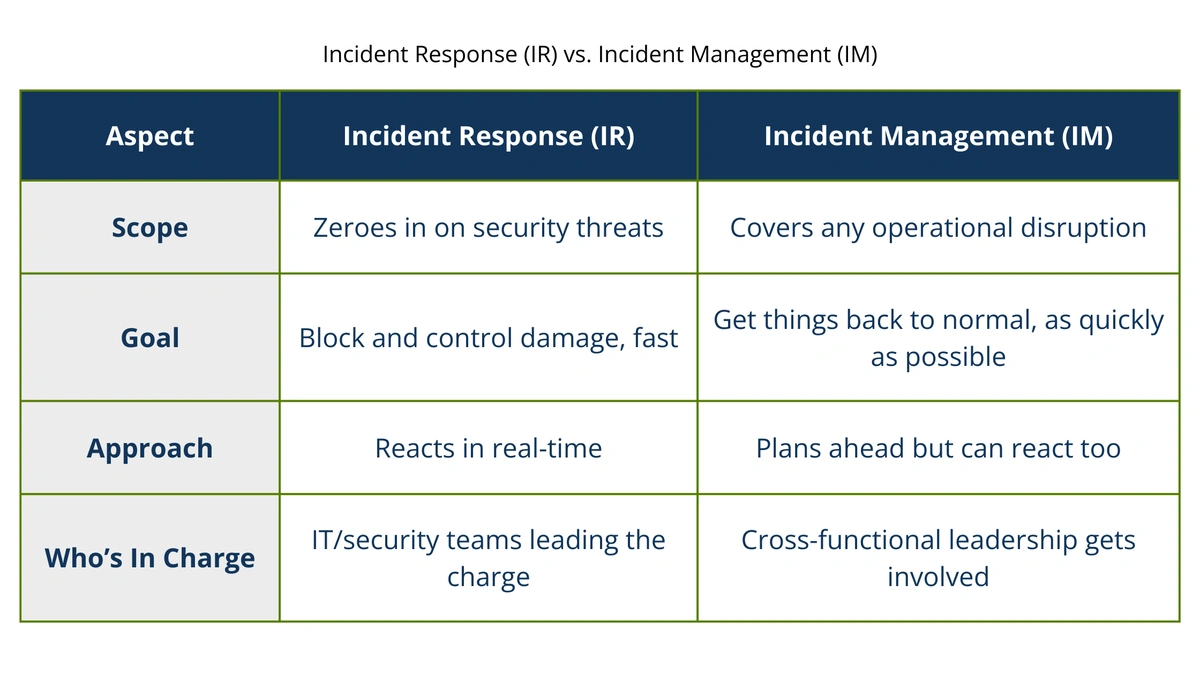Let’s be honest—if you work in IT or risk management, you know the feeling of your heart racing when something goes wrong. Cybersecurity breaches and operational disruptions aren't just distant threats—they’re part of daily reality. But how an organization responds? That can make all the difference. There are two major approaches that shape this response: Incident Response (IR) and Incident Management (IM). They both matter more than you might realize, but figuring out where one ends and the other begins is where teams can get tripped up.
Stick with me, and you’ll discover what sets these two pillars apart, why you actually need both to have your organization’s back, and how Learning Tree International’s training can give your team a winning edge.

What Is Incident Response?
Incident Response is what happens when your team springs into action the moment something goes wrong—think of it as the “firefighter mode” of IT. We’re talking about step-by-step plans to identify, investigate, contain, and recover from threats like malware attacks, phishing scams, or data breaches.
Here’s what makes Incident Response tick:
- Reactive Focus: Teams drop everything to address the problem right in front of them.
- Primary Goal: Stop the bleeding—mitigate damage fast by isolating the threat.
- Execution: Rely on tried-and-true playbooks for situations like ransomware where every minute counts.
A Story from the Front Lines
Let’s put a human face on this. Imagine Sarah, an IT manager at a fast-growing online retailer. It’s 2 a.m. when her phone buzzes. She sees an alert about suspicious server activity. Within moments, Sarah gathers her team, coffee mugs in hand, and confirms her worst fear: ransomware is encrypting customer data. Instinct kicks in—they isolate the servers, pull backups online, and by sunrise, customers are shopping as usual. Sarah takes a deep breath, feeling both exhausted and grateful.
That’s Incident Response. It’s about being there, in the moment, making decisions that protect your brand and bring relief to colleagues and customers alike.
What Is Incident Management?
While Incident Response is about urgent action, Incident Management is your organization’s overall playbook for any disruption—not just cyber threats. It covers everything: power outages, server crashes, even supply chain hiccups. Think of it as the big picture strategy to keep your business running, come what may.
Core characteristics of Incident Management:
- Proactive and Strategic: Start with planning and prevention, so when disaster hits, you already know the next move.
- Primary Goal: Restore normal operations efficiently—with minimal pain for everyone involved.
- Execution: It’s teamwork at its best, assigning roles, activating workflows, and keeping the entire organization informed.
A Real-World Example
Consider GlobalShip, a shipping company relying on complex logistics. One December night before the holidays, a critical server goes down, threatening thousands of deliveries. The Incident Management plan kicks in: shipments rerouted, contingency systems deployed, and customers instantly notified with honest updates. Despite a sleepless night for operations, the company keeps its promises, and the customer support team ends the season with more thank-you notes than complaints.
That’s the comfort of knowing Incident Management isn’t just a buzzword—it’s a lifeline for business continuity, customer trust, and employee wellbeing.
Incident Response vs. Incident Management: See the Difference
It might sound like these two are interchangeable, but here’s where things get interesting:

If you’re picturing IR and IM as peanut butter and jelly, you’re onto something—they’re good alone, but much better when combined.
Why You Need Both—Not Just One
What happens when you focus too much on one and forget the other? Picture this:
- Incident Response Without Management:
Let’s say Sarah’s team stops the ransomware. If there’s no broader Incident Management, the business might stay offline for days, customer support is flooded, and the damage ripples far beyond IT.
- Incident Management Without Response:
Conversely, a company might keep everyone calm and informed but fail to stop the technical problem at its core, so the incident becomes worse than it needed to be.
The takeaway: These two work best hand-in-hand. Together, they protect both the technical and human sides of your business—preventing layoffs, lost revenue, and sleepless nights for everyone.
How to Train for Real-Life Incidents
Let’s face it: handling complex threats takes skill and coordination across different teams. That’s why Learning Tree International creates training that’s as real as it gets, weaving together strategy and hands-on practice.
A Few Programs Making a Difference
- Certified Incident Handler (ECIH) Training:
Perfect for those who want to step into the front lines, equipping individuals to spring into action against threats. See Dates.
- Disaster Recovery and Business Continuity Training:
With ISO 22301 as the backbone, this program is all about planning for “what if” scenarios—helping organizations bounce back stronger. See Dates.
- ServiceNow Security Incident Response Training:
See how tech empowers teams to act smarter and faster under stress, leveraging scalable platforms. See Dates.
- Certified Information Security Manager (CISM) Training:
Ideal for those looking to blend business goals with top-tier security management. See Dates..
Every course blends practical examples with real-world simulation—so your team isn’t just learning theory, but how to act when it counts.
Pro Tips for Every Incident
If you want to build a team that doesn’t flinch under pressure, consider these battle-tested ideas:
- Test Your Plans: Run drills regularly—tabletop exercises, simulations—so your response is sharp when the pressure is on.
- Create Clear Roles: Map out who’s responsible for what, so teams aren’t tripping over each other in a crisis.
- Communicate, Communicate, Communicate: Honest, speedy updates to everyone (yes, even those tough customer emails) can save your reputation.
- Use the Right Tools: Invest in resources that make action seamless, like SOAR platforms or Incident Management software. Imagine them as your air traffic control during turbulence.
Bring Learning Tree Along for the Journey
Here’s the truth: resilience is about more than technology. It’s about knowledge, practice, and having each other’s backs. Learning Tree International crafts programs that give you clarity, confidence, and capability—so when the unexpected hits, your people step up.
If you’re ready for less stress and more confidence, why not empower your team now? Let’s make your organization the one that customers and employees rely on—even when things go sideways.
Ready to build resilience together? Check out Learning Tree’s latest training options and find your next step.
Because being prepared means everyone can breathe a little easier, knowing you’re not just ready—you’re truly resilient.


